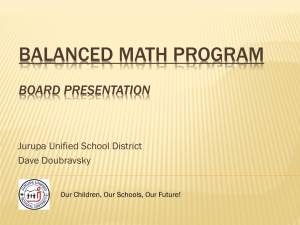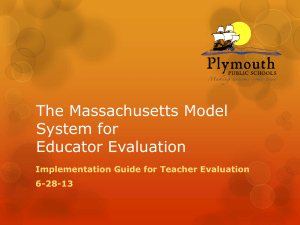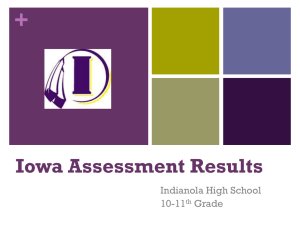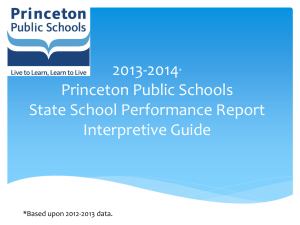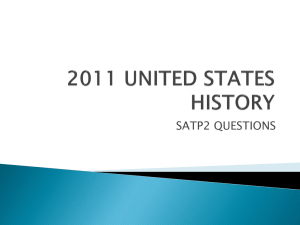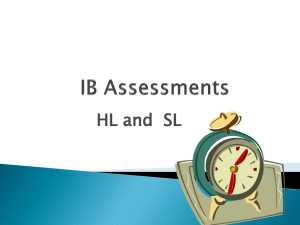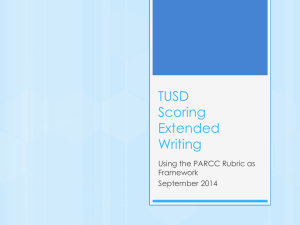A few tips! - Broward County Public Schools
advertisement
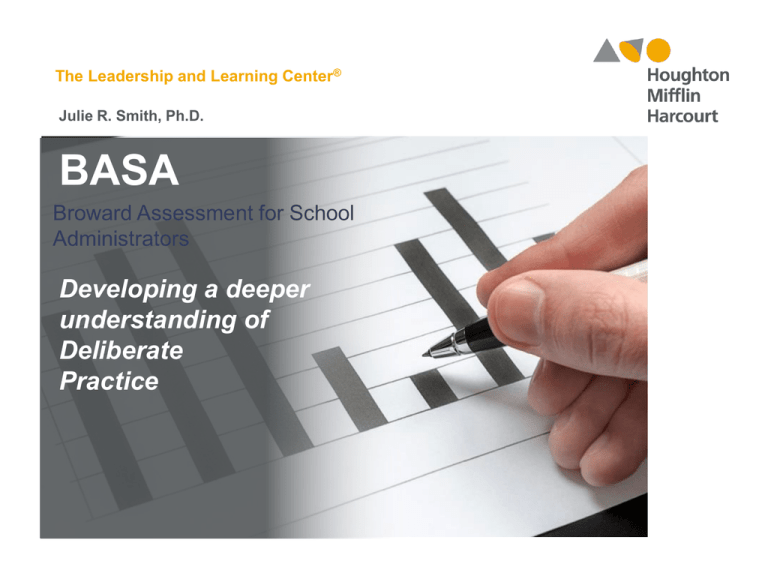
The Leadership and Learning Center® Julie R. Smith, Ph.D. BASA Broward Assessment for School Administrators Developing a deeper understanding of Deliberate Practice The Leadership and Learning Center® Broward County Schools District Learning Intention/ Success Criteria • Briefly review the five elements that make up the Deliberate Practice process and know how it connects to your School Improvement Plan • Understand what a “Proficiently” created Deliberate Practice Plan looks like and implement the DP Development and implementation at a proficient or higher level • Begin the process to develop a “Proficient” Deliberate Practice Plan Reflections With a table partner, briefly discuss the components of Deliberate Practice (DP) and share your learnings from your 2012-2013 DP plan. DP Growth Target Template Viviane Robinson’s Findings Barometer of Influences on Achievement 0.30 0.20 0.40 0.50 0.60 0.10 0.70 0 Zone of desired effects 0.80 0.90 1.00 Hinge Point=0.40 Elements of Deliberate Practice • Focus Issue (Why worth pursing?) • Growth Target (What expect to know/do?) • Anticipated Gains (What hope to learn?) • Plan of Action (How accomplish?) • Progress Points (What to monitor?) DP Development Rubric Selecting Growth Targets Growth Target Explanation Growth Target #1 An issue that addresses a school improvement need related to student learning and either selected by the district or approved by leader’s supervisor. The focus should be on complex issues that take some time to master such as providing observation and feedback of high-effect size instructional practices. Growth Target #2 An issue related to a knowledge base or skill set relevant to instructional leadership (selected by leader). Growth Targets #3 and 4 Optional: additional issues as appropriate. The addition of more targets should involve estimates of the time needed to accomplish targets 1 and 2. Where targets 1 and 2 are projected for mastery in less than half of a school year, identify additional target(s). BASA Self-Assessment Narrowing the Focus Self-assessment of all 45 Indicators Lowest scored indicators ALL Domains Lowest scored “weighted” Indicators Domains 1 & 2 Lowest scored Indicators Proficiency Area 4 1-2 High-leverage Leadership Indicators Focus Issue Why is the target worth pursuing? The leader’s SMART Goal is drawn directly from the school’s School Improvement Plan… 12 Sample Focus Issue By June 2014, there will be an increase to 90% (394), of all 10th grade students that score a level 4.0 or higher on the Florida Writes Test. Cut and Paste SIP Goal Learning Activity Considering your School Improvement Plan and the data you have reviewed (Targeted area of low student performance and a related prioritized area of adult performance), capture a FOCUS ISSUE (SMART Goal) that is worthy of devoting your time, leadership knowledge, skills, and influence. Growth Target Describe what you expect to know/do? The leader’s Growth Target is a product of Of your “Narrowing” process… 1-2 BASA Indicators briefly described or leader’s growth target 16 Deliberate Practice Focus and Growth Target Formula School Improvement Plan SMART Goal Leader's Growth Target (2-3 BASA Indicators) DP Focus and Growth Target Sample Growth Target Indicator 3.6 - Faculty Effectiveness: The leader monitors the effectiveness of classroom teachers and uses contemporary research and the district’s instructional evaluation system criteria and procedures to improve student achievement and faculty proficiency on the FEAPs. Indicator 4.2 Feedback Practices: The leader monitors, evaluates proficiency, and secures and provides timely and actionable feedback to faculty… Sample Focus Issue Growth Target Your Prioritized BASA Indicators Should… • Result in improved teaching and leadership performance to positively impact student achievement • Require the help of a teacher or “coach” or securing additional professional development • Be designed to stretch you beyond your current abilities • Isolate remarkably specific aspects of your practice and focus your time and energy on just those things until they are improved Learning Activity Your turn. Identify your 1-2 prioritized “Growth Targets” from your “narrowing” process. Write them out on your plan. Anticipated Gains Describe what you hope to learn? Learning barrier Instructional practice Leadership practice 22 Sample Anticipated Gains • Become keenly aware of the barriers to proficient • • student performance to elaborate with both their expository and persuasive writing Develop an awareness of the instructional practices that appear to most help students overcome those barriers as well as those that don’t have a positive relationship to improvements in student writing performance Determine whether or not the selected leadership strategy was having the desired impact or not Anticipated Gains What You Hope To Learn from Your Efforts Learning Activity Your turn. What do you hope to learn? Describe your Learning barrier, Instructional practice, and Leadership practice Share your thinking with a Shoulder Partner. Plan of Action How will you accomplish the target? Observable Measurable Formative language Frequently checked Application of BASA 26 Cause and Effect Examples Cause Effect A Plan of Action Statement THEN… IF… Plan of Action If I Increase the percent of faculty implementing instruction in methods of elaboration with expository, narrative, persuasive and text-based writing at the “Proficient” and higher levels using a locally developed rubric Plan of Action Theory of Action Statement Sample Descriptions IF I engage staff in an in-depth study of key non-fiction writing instruction cross content professional development followed by the proficient implementation of these non-fiction writing practices in all classes, THEN… IF I increase the percentage of time spent during faculty meeting discussions related to targeted student achievement monthly, THEN… IF I Increase the percentage of faculty who achieve a r=.80 level of agreement monthly on the collaborative scoring of (insert subject) anonymous student work, THEN… IF I increase the percentage of Data Teams (PLCs) whose common formative assessments are developed at the “proficient” or higher levels monthly, THEN… Samples of Measurable “IF” Statements Include… • IF I increase the number of targeted, sub-group writing assessments scored by the principal (me) monthly using the school’s collaboratively developed rubric…THEN… • IF we increase the number of Data Teams™ (PLCs) the building leader meets with monthly to review scored samples of “targeted” student work from key assignments…THEN… • IF we increase the number of (reading or writing or mathematics) bestpractice strategies modeled during faculty meetings monthly that are “proficiently” incorporated into classroom instructional practice…THEN… • IF we increase the number of teachers using high yield instructional practices at the proficient level as defined by a rubric…THEN… Sample Plan of Action Statement If I Increase the percent of faculty implementing differentiated writing instruction at the “Proficient” or higher level based on both direct observation and teacher self-assessment monthly using a locally developed rubric. Learning Activity Your turn. Describe a measurable Plan of Action “IF” statement. Progress Points Progress points that allow monitoring? Plan of Action (leader) Formative Assessment (student) 34 A Plan of Action Statement THEN… IF… Progress Points • The percent of staff monthly implementing at the “Proficient” or higher level instruction in methods of elaboration with expository, narrative, persuasive and text-based writing Percent of students scoring at the “Proficient” or higher level on expository and persuasive writing assessment monthly scored using a locally developed rubric • The percent of students scoring proficient or higher on a locally agreed upon writing rubric Testing the Hypothesis THEN they would expect to see similar increases in the percent of students scoring at the “Proficient” or higher levels of a locally developed writing assessment using a sitedeveloped rubric. IF the leader and his/her teachers demonstrate monthly increases in faculty who proficiently (or higher) implement differentiated writing instruction (using a locally developed rubric), Cause and Effect Examples Then Cause IF Effect Hypothesis Testing IF… THEN… IF I engage staff in an in-depth study THEN, I expect to see an increase in of key non-fiction cross content writing instruction professional development followed by the proficient implementation of these non-fiction writing practices in all classes… the students’ proficient and higher cross content writing performance monthly to a non-fiction writing prompt IF I conduct 30 classroom THEN, I expect to see an increase in observations per week and provide feedback, which is acted upon by teachers to improve reading comprehension instructional practices… the percent of proficient and higher students (reading comprehension) monthly assessment Or… • IF we increase the percentage of faculty members whose self-reported levels of implementation on the (insert initiative) rubric is consistent with observed levels of implementation in the same area monthly, THEN student reading comprehension will increase • IF we increase the number of teachers who engage in peer observation, reflection, and application to improve personal practices monthly, THEN student writing achievement will increase Samples of Measurable “THEN” Student Progress Points… • THEN I expect to see the percent of students scoring “Proficient” or higher on a monthly writing assessment increase using a locally developed rubric • THEN I expect to see an increase in the percent of students scoring at the “Proficient” or higher level on a monthly reading comprehension assessment using a school-developed rubric • THEN I expect to see an increase in the percent of students scoring at the “Proficient” or higher level on a monthly problem solving assessment using a locally developed rubric Sample Progress Point Statements Learning Activity Your turn. Rewrite your “IF” Action plan statement and describe a measurable “THEN” student progress point statement (which you add to the action plan statement). Share these two components of your DP with your table group. Monitoring and Measuring Your Deliberate Practice Plan Collect cause data Collect effect data Chart monthly Share data publicly Modify as needed 44 Hypothetical Comparison Adult to Student Achievement Degree of Implementation vs Impact on Student Achievement Results 90 Percent Proficient 80 70 60 50 % faculty implementing differentiated writing instruction at the proficient or higher level % of students that are proficient or higher on a monthly writing assessment 62 65 77 65 60 55 50 50 45 40 30 "IF" 30 "THEN" 20 10 0 September October November January February "IF" 30 50 60 55 65 "THEN" 45 62 50 65 77 Monitoring Fequency Classroom Discussion 0.82 Effect Size Ranked 7th overall out of 150 influences on student achievement 46 Questioning 0.48 Effect Size Ranked 53rd overall out of 150 influences on student achievement 47 Visible Learning “…Questioning was the second most dominant teaching method (after teacher talk)…35-50 percent of teaching time posing questions…60 percent of which are recall.” .48 ES Teachers Talk, Talk, and Talk… • Classrooms are dominated by • • • • • 50 teacher talk Accounts for 70-80% of class time, on average Follows a typical pattern: teacher initiation, student response, and teacher evaluation or IRE pattern IRE pattern fosters lower-order cognitive learning Less than 5% of class time devoted to group discussion 5-10% of teacher talk triggers more conversation or dialogue engaging the student Listen to Students’ Learning • Listening to students’ dialogue • Students and teachers joining together in addressing questions or issues of common concern • Considering and evaluating differing ways of addressing and learning • Exchanging and appreciating each other’s views 51 Marzano Teacher Evaluation 52 53 Danielson Sample Rubric The Danielson Group. (n.d.) The Framework for Teaching: Evaluation Instrument. Retrieved May 27, 2013, from http://www.danielsongroup.org/userfiles/files/downloads/2013EvaluationInstrument.pdf 54 Focused Walkthroughs Teacher Questions/Discussion Data Gathering Classrooms Visited 1 2 3 4 5 ✓ ✓✓ ✓✓ ✓✓✓ ✓✓✓ ✓✓✓ ✓✓✓ ✓✓✓ ✓ ✓✓✓ ✓✓✓ ✓✓ ✓✓✓ ✓✓✓ ✓✓✓ ✓ ✓✓✓ ✓ ✓✓✓ ✓✓✓ ✓ ✓✓✓ ✓✓✓ ✓✓✓ ✓✓ ✓✓✓ ✓✓✓ ✓ ✓✓ Distinguished Level 4: Students initiate higher-order questions The teacher builds on and uses student responses to questions in order to deepen student understanding Students extend the discussion, enriching it Students invite comments from their classmates during a discussion and challenge one another’s thinking Virtually all students are engaged in the discussion Proficient Level 3: The teacher uses open-ended questions, inviting students to think and/or offer multiple possible answers The teacher makes effective use of wait time Discussions enable students to talk to one another without ongoing mediation by the teacher The teacher calls on most students, even those who don’t initially volunteer Many students actively engage in the discussion The teacher asks students to justify their reasoning, and most attempt to do so Basic Level 2: The teacher frames some questions designed to promote student thinking, but many have a single correct answer, and the teacher calls on students quickly The teacher invites students to respond directly to one another’s ideas, but few students respond The teacher calls on many students, but only a small number actually participate in the discussion The teacher asks students to explain their reasoning, but only some students attempt to do so Unsatisfactory Level 1: Questions are rapid-fire and convergent, with a single correct answer Questions do not invite student thinking All discussion is between the teacher and students; students are not invited to speak directly to one another The teacher does not ask students to explain their thinking Only a few students dominate the discussion 55 Focused Walkthrough Data Percent of Classrooms Teacher Questions/Discussion 100% 90% 80% 70% 60% 50% 40% 30% 20% 10% 0% 10 20 20 13 65 67 20 15 75 September October November Frequency of Data Collection Level 1-2 56 15 Level 3 Level 4 22 58 December Feeser Elementary School SelfAssessment, ObservationalAssessment vs Student Achievement Percent Proficient 120 100 80 60 84 74 81 68 90 8077 96 71 57 54 53 54 36 40 27 20 94 87 41 43 33 9 0 Sept Oct Self-Assessment Nov Dec Observed-Assessment Jan Feb Mar Writing Achievement DP Development Rubric Check the DP Components Focus Issue A SMART Goal from the school’s SIP Growth Target 1-2 Prioritized BASA Indicators Anticipated Gain(s) Describes what the leader hopes to learn about– • The obstacles to proficient student performance within the content area in the Focus Issue • Which instructional practices are related • Whether the leadership strategy is having an impact Plan of Action A single strategy that is measurable, observable and time bound, which requires the leader to apply the prioritized FSLA Indicators in the Growth Target Progress Points Only two progress points are identified— • The Plan of Action statement (the adult measure) • A formative student achievement measure related to the content identified within the Focus Issue 59 A Completed DP Template Compare Deliberate Practice Development Rubric and School Leader Plan Focus Issue Growth Target Anticipated Gains Plan of Action Progress Points 61 DP Implementation Rubric The Leadership and Learning Center® Broward County Public Schools Questions and Next Steps Julie R. Smith, Ph.D. Julie.smith@hmhco.com 720-470-1146 (cell phone)

